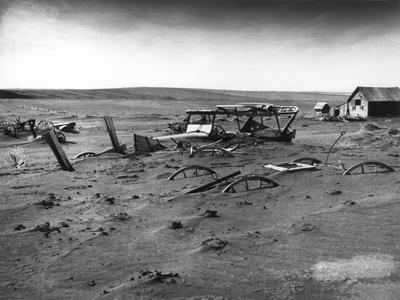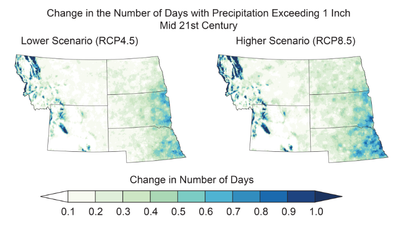The region is projected to be hit by dozens more days with temperatures above 100 degrees F.
Much has changed in the U.S. heartland since the 1930s, with widespread irrigation and — on some farms — improved agricultural practices. But given the rising temperatures and worsening droughts caused by gobal warming, some scientists are asking whether the U.S. breadbasket is headed for another Dust Bowl.
In a 2018 National Climate Assessment, U.S. scientists warned that under current warming scenarios, temperatures in the southern Great Plains could increase by 3.6 to 5.1 degrees F by 2050 and by 4.4 F to 8.4 F by 2100, compared to the 1976-2005 average. The region is projected to be hit by dozens more days with temperatures above 100 degrees F. Temperature increases are likely to be less severe in the northern part of the region, but the entire Great Plains is nevertheless expected to weather both more heatwaves and periods of extreme drought, according to the National Climate Assessment.
The seeds of the Dust Bowl were sown when farmers in the early 20th century tore out millions of acres of hardy native grasses to plant wheat and corn during a relatively wet period. Then, when a historic, multi-year drought and heatwave occurred in the 1930s, the crops died and the exposed topsoil was left dry and loose, ripe to be swept away by strong winds. The ensuing storms could be immense: On April 14, 1935, the “Black Sunday” dust storm lofted central plains topsoil all the way to the cities of the East Coast. By the time the Dust Bowl was over, millions of migrants had fled the once-promising Great Plains for California and other western states.
But the catastrophe spurred innovation, too. In the midst of the Dust Bowl, the government acted quickly to establish the Soil Conservation Service, which helped promote more sustainable techniques like no-till agriculture and cover cropping, which reduce the amount of exposed soil. Many of the heartland’s industrial-scale farming operations, however, did not adopt these practices, though in recent years no-till agriculture has become more widespread.
Since the 1940s, many farmers on the Great Plains also have extensively irrigated their crops, allowing them to weather dry periods and further preventing topsoil erosion. But that reliance on irrigation has left the Great Plains open to new dangers. The Ogallala Aquifer — which makes up most of the High Plains Aquifer System and supplies the water for 30 to 46 percent of irrigated land in some Great Plains states — has been steadily overdrawn in recent decades; by some estimates, the Ogallala Aquifer could be 70 percent depleted within 50 years.
“There comes a point where if you’re not replenishing those resources like aquifers, then all you need is the next minor drought to come along, and if you don’t respond, then you run the risk of another Dust Bowl-like event,” says Tim Cowan, a senior research fellow at the University of Southern Queensland who studies the effects of climate change on precipitation and heatwaves.
Heat and drought are intimately linked, meaning that worsening heatwaves mean more droughts and vice versa. That one-two punch has many scientists concerned. “Dry soils have this exacerbating effect,” says Wim Thiery, a climate scientist at the University of Brussels. “There is this positive feedback where dry soils lead to more warmth.”
When the soil contains a lot of moisture, incoming energy from the sun gets absorbed by the water as it turns from a liquid into a gas. But when the soil contains little water, that energy is converted directly into heat. The result is that droughts lead to more severe heatwaves, and those heatwaves in turn lead to drier conditions.
Corn and soy crop yields would decline by 40 percent in a modern Dust Bowl scenario.
Data shows that both drought and heat are becoming more common — and perhaps increasing the feedback effects between them. In a recent study in Nature, Cowan and his coauthors found that greenhouse gas emissions have made a period of Dust Bowl-like heatwaves more than two-and-a-half times more likely compared to the 1930s.
Ben Cook, a climate scientist at the NASA Goddard Institute for Space Studies, says the same goes for drought. “What we’re seeing in a lot of regions is this kind of amplified evaporation effect that’s making it … easier to get into drought, a little bit harder to get out of drought, and making the droughts themselves a bit more intense than they would have been in a colder world.”
Meanwhile, agriculture continues to thrive in the Midwest and Great Plains. The combined regions are top producers of crops like corn, wheat, and soybeans, as well as livestock. That level of agricultural intensity, paired with increasingly hotter weather, raises the stakes for the United States should another historic drought occur.
One paper in 2016 relied on computer simulations to model the effects of Dust Bowl conditions on modern agriculture. Corn and soy crop yields would decline by around 40 percent, the authors estimate, and wheat yields would drop 30 percent. And every one degree Celsius (1.8 F) increase in temperature would cause the effects to worsen by 25 percent.
In a world where drought and heatwaves become routine, the two might combine to tip the country into a situation where agriculture becomes increasingly threatened, with profound impacts on U.S. food supplies.
Projected changes are shown for the annual number of very hot days and heavy precipitation events in the mid-21st century. GlobalChange.gov
The United State got a recent taste of Dust Bowl-like conditions. In 2012, the country experienced one of its worst droughts on record, along with a sizzling heatwave. La Niña conditions in the Pacific Ocean, combined with the lingering effects of a dry 2011, resulted in the driest summer in the U.S. since 1988. By July, nearly two-thirds of the country was in drought conditions, according to the U.S. Drought Monitor. Meanwhile, July 2012 was the second-hottest month on record at the time.
The effects on the nation’s farmers were substantial. Estimates put agricultural losses at around $30 billion, and corn yields declined by 26 percent. But even though the 2012 drought was similar in character to the Dust Bowl, billowing dust storms and wholesale agricultural collapse were absent. Similarly, a severe drought in the 1950s also failed to kick off another Dust Bowl.
“We’ve had bad droughts in the Central Plains since the Dust Bowl, but we haven’t had the same level of land degradation and dust storm activity,” Cook says. “And part of the reason for that is because our land use practices have changed.”
For the time being in the Great Plains, irrigation allows farmers to weather even severe droughts by drawing on water stored in underground aquifers. But the overuse of the High Plains Aquifer System, especially the Ogalalla Aquifer, is taxing the region’s groundwater supplies. Since 1987, the U.S. Geological Survey (USGS) has been gathering yearly data on water levels in the High Plains Aquifer by monitoring thousands of wells.
Though changes vary across the region, the overall picture is one of persistent decline, says Virginia McGuire, a hydrologist with the USGS who’s been monitoring the aquifer for more than two decades. The volume of water in the aquifer in 2015 had fallen by 273.2 million acre-feet since irrigation began in the 1940s, according to a USGS report she authored. A map in the report shows red blotches spread across Texas, Oklahoma, and Colorado, revealing stark declines in the amount of water infusing the soil. Water levels in some places are less than half of what they were a century ago, McGuire says.
“If that trend doesn’t change, at some point there’s going to have to be a reckoning,” she says.
“You will reach the point at which there is no more water coming from the wells,” says one expert.
So much irrigation is taking place on the Great Plains and in other global agricultural zones that the added water is actually cooling regional temperatures. In a 2020 paper in Nature Communications, Thiery and his colleagues compared average temperatures in heavily irrigated regions to those in the rest of the world. “We found that irrigation has a pretty pronounced cooling effect,” he says. Regions that were irrigated warmed on average by 0.8 C (1.5 F) less on hot days than the rest of the world, they found. But the cooling effect of large-scale irrigation is ultimately unsustainable.
“We are putting massive pressure on our groundwater resources by irrigating,” Thiery says. “At some point you will reach the point at which there is no more water coming from the wells.”
Water managers and farmers are already making changes to reduce water use, such as irrigating just half of their fields, or using multiple smaller wells to increase water yields from parched groundwater reserves, according to McGuire. But depleted aquifers take a long time to recharge, especially in areas like the southern Plains, where the water table is far below the surface. Meanwhile, dry years continue to stress the aquifer. During the three-year period between 2011 and 2013, the aquifer lost nearly as much water as it did between 1980 and 1995.
In 2012, says Cook, “the system was resilient enough to deal with a single year of really bad drought in the central U.S. Now, if that 2012 drought had lasted three, four, or five years, would our system have been able to handle that? That I don’t know.”
Eastern Colorado farmer Jay Sneller watches the mowing of his drought-ravaged corn crop during the drought of 2012. John Moore / Getty Images
A key reason for the resilience of U.S. agriculture is the government’s ability to provide aid to farmers when times are tough, Cook says. But climate change is affecting the entire world, with hotter, drier conditions predicted to increase in regions — such as South Asia and East Africa — that may have little ability to cope with more extreme weather. In the Indian state of Punjab, where more than 80 percent of the land is used for agriculture, water tables are dropping quickly. A 2019 heatwave in India saw temperatures climb above 120 F, while water shortages led to violent clashes.
A European drought has also strained groundwater resources across much of the continent. Data from NASA’s GRACE-FO satellite from June 2020 revealed dangerously dry soils in Germany, Poland, the Czech Republic, Ukraine, and parts of Russia. Similarly, a record-setting drought in Australia from 2017-2019 battered farmers, with extreme heat also sweeping across the country. Even if nations — particularly developing nations — adopt more sustainable irrigation and agricultural practices, a rapidly changing climate means they could still face crop failures that imperil food supplies.
The Dust Bowl is a uniquely American touchstone, a story of hardship and eventual triumph that has come to define both our country’s historical narrative and physical reality. But in a world where climate conditions grow steadily more extreme, that unparalleled disaster could become far more common.







